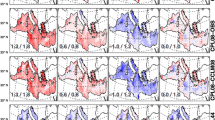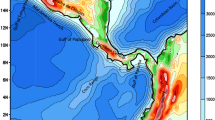Abstract
The current literature provides compelling evidence suggesting that an eddy-resolving (as opposed to eddy-permitting or eddy-parameterized) ocean component model will significantly impact the simulation of the large-scale climate, although this has not been fully tested to date in multi-decadal global coupled climate simulations. The purpose of this paper is to examine how resolved ocean fronts and eddies impact the simulation of large-scale climate. The model used for this study is the NCAR Community Climate System Model version 3.5 (CCSM3.5)—the forerunner to CCSM4. Two experiments are reported here. The control experiment is a 155-year present-day climate simulation using a 0.5° atmosphere component (zonal resolution 0.625 meridional resolution 0.5°; land surface component at the same resolution) coupled to ocean and sea-ice components with zonal resolution of 1.2° and meridional resolution varying from 0.27° at the equator to 0.54° in the mid-latitudes. The second simulation uses the same atmospheric and land-surface models coupled to eddy-resolving 0.1° ocean and sea-ice component models. The simulations are compared in terms of how the representation of smaller scale features in the time mean ocean circulation and ocean eddies impact the mean and variable climate. In terms of the global mean surface temperature, the enhanced ocean resolution leads to a ubiquitous surface warming with a global mean surface temperature increase of about 0.2 °C relative to the control. The warming is largest in the Arctic and regions of strong ocean fronts and ocean eddy activity (i.e., Southern Ocean, western boundary currents). The Arctic warming is associated with significant losses of sea-ice in the high-resolution simulation. The sea surface temperature gradients in the North Atlantic, in particular, are better resolved in the high-resolution model leading to significantly sharper temperature gradients and associated large-scale shifts in the rainfall. In the extra-tropics, the interannual temperature variability is increased with the resolved eddies, and a notable increases in the amplitude of the El Niño and the Southern Oscillation is also detected. Changes in global temperature anomaly teleconnections and local air-sea feedbacks are also documented and show large changes in ocean–atmosphere coupling. In particular, local air-sea feedbacks are significantly modified by the increased ocean resolution. In the high-resolution simulation in the extra-tropics there is compelling evidence of stronger forcing of the atmosphere by SST variability arising from ocean dynamics. This coupling is very weak or absent in the low-resolution model.



















Similar content being viewed by others
Notes
Throughout this paper, model “resolution” refers to the spacing of model grid elements.
In common parlance, eddy-resolving models have horizontal resolution of less than 1/6°, in contrast to eddy-parameterized models with 1° or greater grid spacing or eddy-permitting ocean models whose resolution lies between 1/6° and 1°.
References
An S-I (2008) Interannual variations of the tropical instability wave and ENSO. J Climate 21:3680–3685. doi:10.1175/2008JCLI1701.1
Barsugli JJ, Battisti DS (1998) The basic effects of atmosphere-ocean thermal coupling on midlatitude variability. J Atmos Sci 55:477–493
Brankovic C, Gregory D (2001) Impact of horizontal resolution on seasonal integrations. Clim Dyn 18:123–143. doi:10.1007/s003820100165
Brunet G et al (2010) Collaboration of the weather and climate communities to advance subseasonal-to-seasonal prediction. Bull Am Meteor Soc 91:1397–1406
Bryan FO, Hecht MW, Smith RD (2007) Resolution convergence and sensitivity studies with North Atlantic ciculation models. Part I: the western boundary current system. Ocean Model 16:141–159
Bryan FO, Tomas R, Dennis JM, Chelton DB, Loeb NG, McClean JL (2010) Frontal scale air–sea interaction in high-resolution coupled climate models. J Climate 23:6277–6291. doi:10.1175/2010JCLI3665.1
Burgman RJ, Schopf PS, Kirtman BP (2008) ENSO decadal variability. J Climate 21:5482–5550
Casey KS, Brandon TB, Cornillon P, Evans R (2010) The past, present and future of the AVHRR pathfinder SST program. In: Barale V, Gower JFR, Alberotanza L (eds) Oceanography from space: revisited. Springer, Berlin. doi:10.1007/978-90-481-8681-5_16
Chelton DB, Esbensen SK, Schlax MG, Thum N, Freilich MH, Wentz FJ, Gentemann CL, McPhaden MJ, Schopf PS (2001) observations of coupling between surface wind stress and sea surface temperature in the eastern Tropical Pacific. J Climate 4:1479–1498
Chiang JCH, Bitz CM (2005) Influence of high latitude ice cover on the marine intertropical convergence zone. Clim Dyn. doi:10.1007/s00382-005-0040-5
Comiso J (1999) updated 2008./Bootstrap sea ice concentrations from Nimbus-7 SMMR and DMSP SSM/I/. National Snow and Ice Data Center, Digital media, Boulder, CO
Craig AP, Jacob R, Kauffman B, Bettge T, Larson J, Ong E, Ding C, He Y (2005) CPL6: the new extensible, high performance parallel coupler for the community climate system model. High Perf Comp Appl 19:309–328
Craig A, Vertenstein M, Jacob R (2011) A new flexible coupler for earth system modeling developed for CESM4 and CESM1. Int J High Perf Comput Appl 26:31–42. doi:10.1177/1094342011428141
Delworth TL, Rosati A, Anderson W, Adcroft AJ, Balaji V, Benson R, Dixon K, Griffies SM, Lee H-C, Pacanowski RC, Vecchi GA, Wittenberg AT, Zeng F, Zhang R (2012) Simulated climate and climate change in the GFDL CM2.5 high-resolution coupled climate model. J Climate 25:2755–2781. doi: 10.1175/Jcli-D-11-00316.1
Dennis JM, Vertenstein M, Worley P, Mirin A, Craig A, Jacob R, Mickelson S (2012) Computational performance of ultra-high resolution capability in the community earth system model. Int J High Perf Comput Appl 26:5–16. doi: 10.1177/1094342012436965
Deser C, Tomas R, Alexander M, Lawrence D (2010) The seasonal atmospheric response to projected arctic sea ice loss in the late twenty-first century. J Climate 23:333–351. doi:10.1175/2009JCLI3053.1
Gent PR, Yeager SG, Neale RB, Levis S, Bailey DA (2010) Improvements in a half degree atmosphere/land version of the CCSM. Clim Dyn 34:819–833
Hack JJ, Caron JM, Danabasoglu G, Oleson KW, Bitz C, Truesdale JE (2006) CCSM–CAM3 climate simulation sensitivity to changes in horizontal resolution. J Climate 19:2267–2289. doi:10.1175/JCLI3764.1
Hecht MW (2010) Cautionary tales of persistent accumulation of numerical error: dispersive centered advection. Ocean Model 35:270–276. doi:10.1016/J.Ocemod.2010.07.005
Hurrell J, Meehl GA, Bader D, Delworth TL, Kirtman B, Wielicki B (2009) A unified modeling approach to climate system prediction. Bull Am Meteor Soc 90:1819–1832
Jochum M, Murtugudde R (2004) Internal variability of the tropical Pacific Ocean. Geo Phys Res Lett 31:L14309
Jochum M, Desser C, Phillips A (2007) Tropical atmospheric variability forced by oceanic internal variability. J Climate 20:765–771
Jochum M, Danabasoglu G, Holland MM, Kwon YO, Large WG (2008) Ocean viscosity and climate. J Geophys Res 113. doi:10.1029/2007JC004515
Kalnay E et al (1996) The NCEP/NCAR 40-year reanalysis project. Bull Am Meteor Soc 77:437–471
Kang SM, Held IM et al (2008) The response of the ITCZ to extratropical thermal forcing:idealized slab-ocean experiments with a GCM. J Climate 21(14):3521–3532
Kirtman BP, Schopf PS (1998) Decadal variability in ENSO predictability and prediction. J Climate 11:2804–2822
Kirtman BP, Vecchi G (2010) Why climate modelers should worry about the weather. In: Chang CP, Ding Y, Lau N-C, Johnson RH, Wang B, Yasunari T (eds) The global monsoon system: research and forecast, 2nd ed. World Scientific, Singapore, pp 511–523
Kobayashi C, Sugi M (2004) Impact of horizontal resolution on the simulation of the Asian summer monsoon and tropical cyclones in the JMA global model. Clim Dyn 23:165–176. doi:10.1007/s00382-004-0427-8
Kumar A, Perlwitz J, Eischeid J, Quan X, Xu T, Zhang T, Hoerling M, Jha B, Wang W (2010) Contribution of sea ice loss to Arctic amplification. Geophys Res Lett 37:L21701. doi:10.1029/2010GL045022
Lin S-J, Rood RB (1997) An explicit flux-form semi-Lagrangian shallow water model on the sphere. Q J R Meterol Soc 123:2477–2498
Luo J-J, Masson S, Roeckner E, Madec G, Yamagata T (2005) Reducing climatology bias in an ocean-atmosphere OGCM with improved coupling physics. J Climate 18:2344–2360
Maloney ED, Chelton DB (2006) An assessment of sea surface temperature influence on surface winds in numerical weather prediction and climate models. J Climate 19:2743–2762
Maltrud M, Bryan F, Peacock S (2010) Boundary impulse response functions in a century-long eddying global ocean simulation. Environ Fluid Mech 10:275–295. doi:10.1007/s10652-009-9154-3
Maximenko NA, Hafner J (2010) SCUD: Surface CUrrents from Diagnostic model. IPRC Tech. Note 5, 17 pp. http://iprc.soest.hawaii.edu/publications/tech_notes.php
May W, Roeckner E (2001) A time-slice experiment with the ECHAM4 AGCM at high resolution: the impact of horizontal resolution on annual mean climate change. Clim Dyn 17:407–420. doi:10.1007/s003820000112
McClean JL, Bader DC, Bryan FO, Maltrud ME, Dennis JM, Mirin AA, Jones PW, Kim YY, Ivanova DP, Vertenstein M, Boyle JS, Jacob RL, Norton N, Craig A, Worley PH (2011) A prototype two-decade fully-coupled fine-resolution CCSM simulation. Ocean Model 39:10–30
Meehl GA et al (2001) Factors that affect the amplitude of El Nino in global coupled climate models. Clim Dyn 17:515–526
Minobe S, Kuwano A, Yoshida N, Komori S, Xie P, Small RJ (2008) Influence of the Gulf Stream on the troposphere. Science 452. doi:10.1038/Nature06690
Murray R (1996) Explicit generation of orthogonal grids for ocean models. J Comp Phys 126:251–273
Nakamura M, Enomoto T, Yamane S (2005) A simulation study of the 2003 heatwave in Europe. J Earth Simulator 2:55–69
Navarra A et al (2008) Atmospheric horizontal resolution affects tropical climate variability in coupled models. J Climate 21:730–750. doi:10.1175/2007JCLI1406.1
Neale RB, Richter JH, Jochum M (2008) The impact of convection on ENSO: from a delayed oscillator to a series of events. J Climate 21:5904–5924
Pope V, Stratton R (2002) The processes governing horizontal resolution sensitivity in a climate model. Clim Dyn 19:211–236. doi:10.1007/s00382-001-0222-8
Randall DA, Khairoutdinov M, Arakawa A, Grabowski W (2003) Breaking the cloud-parameterization dead- lock. Bull Am Meteor Soc 84:1547–1564
Roberts MJ, Clayton A, Demory M-E, Donners J, Vidale PL, Norton W, Shaffrey L, Stevens DP, Stevens I, Wood RA, Slingo J (2009) Impact of resolution on the tropical Pacific Circulation in a matrix of coupled models. J Climate 22:2541–2556
Scaife et al (2008) The CLIVAR C20C project: selected twentieth century climate events. Clim Dyn 33:603–614. doi:10.1007/s00382-008-0451-1
Shaffrey LC et al (2009) U.K. HiGEM: The new U.K. High-resolution global environment model—model description and basic evaluation. J Climate 22:1861–1896. doi:10.1175/2008JCLI2508.1
Shukla J, Hagedorn R, Miller M, Palmer TN, Hoskins B, Kinter J, Marotzke J, Slingo J (2009) Strategies: revolution in climate prediction is both necessary and possible: a declaration at the world modelling summit for climate prediction. Bull Am Meteor Soc 90:175–178
Small RJ, Richards KJ, Xie SP, Dutrieux P, Miyama T (2009) Damping of tropical instability waves caused by the action of surface currents on stress. J Geophys Res 114:C04009. doi:10.1029/2008JC005147
Trenberth KE, Caron JM (2001) Estimates of meridional atmosphere and ocean heat transports. J Climate 14:3433–3443
von Storch J-S (2000) Signature of air–sea interactions in a coupled atmosphere-ocean GCM. J Climate 13:3361–3379
Wu R, Kirtman BP (2007) Regimes of local air-sea interactions and implications for performance of forced simulations. Clim Dyn 29:393–410
Wu R, Kirtman BP, Pegion K (2006) Local air-sea relationship in observations and model simulations. J Climate 19:4914–4932
Wu R, Kirtman BP, Pegion K (2007) Surface latent heat flux and its relationship with sea surface temperature in the national centers for environmental prediction climate forecast system simulations and retrospective forecasts. Geophys Res Lett 34:L17712. doi:10.1029/2007GL030751
Xie P, Arkin PA (1997) Global precipitation: a 17-year monthly analysis based on gauge observations, satellite estimates, and numerical model outputs. Bull Am Meteor Soc 78:2539–2558
Acknowledgments
We acknowledge the support of the National Science Foundation (J. Kinter and C Stan through AGS 0830068 and OCI 0749290; B. Kirtman through OCI 0749165, AGS 0754341 and AGS 0850897; C. Bitz through ARC 0938204; F. Bryan, J. Dennis, N. Hearn, R. Loft, R. Tomas and M. Vertenstein through its support of NCAR). B. Kirtman also acknowledges support from the NOAA NA08OAR3420889. Computing resources were provided by the National Institute of Computational Sciences at the University of Tennessee through an award made by the TeraGrid Resource Allocations Committee.
Author information
Authors and Affiliations
Corresponding author
Rights and permissions
About this article
Cite this article
Kirtman, B.P., Bitz, C., Bryan, F. et al. Impact of ocean model resolution on CCSM climate simulations. Clim Dyn 39, 1303–1328 (2012). https://doi.org/10.1007/s00382-012-1500-3
Received:
Accepted:
Published:
Issue Date:
DOI: https://doi.org/10.1007/s00382-012-1500-3




